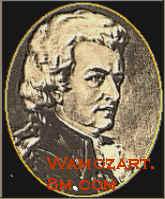 |
Biography | |
| SECTION 1 Ti |
Background
Europe in the early 18th century was marking time, trying to catch its breath after the bloody excesses of the previous century. Religious conflicts had decimated the population of Germany and had fragmented it politically. While large nation-states were taking shape elsewhere, the central part of the continent remained a hodgepodge of independent kingdoms, dukedoms, principalities and cities loosely organized into something called the Holy Roman Empire of the German Nations. Neither holy, Roman nor an empire (as numerous wags through the centuries have noted), this bizarre entity comprised most of the German-speaking countries from the North and Baltic seas to the Alps. Its emperor was the spiritual descendent of Caesar and Charlemagne but he, in fact, possessed little power. Astride the Empire’s southeastern reaches stood another political anomaly, the hereditary domains of the Habsburgs. This empire, sometimes called Austria, was a multinational patchwork stitched together over the centuries by intermarriage, inheritance, military conquest and pure luck. The people of Europe had reason to be grateful to Austria and to its capital, Vienna, in particular. In 1683 a Turkish army, bent on invading the West, had been turned back after laying siege to the city. The erstwhile conquerors left behind sacks of coffee beans, a crescent-shaped pastry soon dubbed the croissant, and a persistent curiosity among the Viennese about all things oriental. This curiosity would eventually express itself in "Turkish" music and in dramatic presentations set in the exotic East, including an opera titled Die Entführung aus dem Serail. But we’re getting ahead of our story. Sandwiched uncomfortably between Austria and neighboring Bavaria was a tiny, independent city-state called Salzburg. The Romans had
been there, long ago. They named it Iuvavum and prized it for its salt
deposits. It also had strategic value: They constructed two roads
through it, presumably to speed their legions northward to defend
against barbarian incursions across the Danube frontier.
Salzburg was an "ecclesiastical principality," administered by a prince-archbishop. The princes could be ruthless: Archbishop Leopold Anton von Firmian settled centuries of religious strife by expelling 22,000 Protestants from Salzburg. Occasionally, they were conscientious and enlightened: One such ruler was the last of Salzburg’s prince-archbishops, Count Hieronymous Colloredo. Mostly, however, they remained remarkably indifferent to their subjects. Their most significant contribution to European culture was their consistent support of the arts, especially music. Because of them, Salzburg "became a great musical city, cross-fertilized by the influences of such musical centers as Venice, Mantua, and Milan on the one hand, and Vienna and Prague on the other hand," writes Mozart biographer Erich Schenk. "Here the Latin and Teutonic tempers met and mingled." In 1737, an
18-year-old Augsburg native named Leopold Mozart arrived in Salzburg to
enroll at the university. After a promising start, he was abruptly
expelled for neglecting his studies. Something had distracted him. That
something may have been music; at any rate, that is where he now turned
to make his way in the world. By 1743 he was accepted into the court
orchestra. By 1763 he was promoted to vice-Kapellmeister, the highest
post he was to achieve. In later years he eventually might have become
Kapellmeister, but by then his court career didn’t really matter. He
had given himself over to something much bigger, a task that he firmly
believed he had been appointed to by God himself.
Once he had established himself, Leopold courted and, on November 21, 1747, married a young Salzburg woman named Anna Maria Pertl. If their correspondence in later years is any indication, it was a good match. No doubt, Anna Maria’s practical good humor provided a healthy counterpoint to her husband’s drive and ambition. There is no question that they were completely devoted to each other. They had seven children; only two survived infancy. The first was Maria Anna Walburga Ignatia, born on July 30, 1751. The second was a boy, born on January 27, 1756.
|